Platelet SR-PSOX/CXCL16–CXCR6 Axis Influences Thrombotic Propensity and Prognosis in Coronary Artery Disease
Abstract
1. Introduction
2. Results
2.1. Platelets may Contribute to Circulatory sCXCL16 and Engage Circulatory sCXCL16
2.2. Platelet CXCL16–CXCR6 Axis may Influence Pro-Thrombotic Disposition in CAD Patients
2.3. Influence of Dyslipidemia and Plasma Lipids on Platelet CXCL16–CXCR6 Axis in CAD Patients
2.4. Association of Platelet CXCL16–CXCR6 Axis and Cardiovascular Risk Factors in CAD
2.5. Association of Platelet CXCL16-CXCR6 with Myocardial Dysfunction and Differential Expression in CCS vs. ACS
2.6. Prognostic Association of Platelet CXCL16-CXCR6 in CAD Patients
3. Discussion
4. Materials and Methods
Author Contributions
Funding
Institutional Review Board Statement
Informed Consent Statement
Data Availability Statement
Acknowledgments
Conflicts of Interest
References
- Chatterjee, M.; Geisler, T. Inflammatory Contribution of Platelets Revisited: New Players in the Arena of Inflammation. Semin. Thromb. Hemost. 2016, 42, 205–214. [Google Scholar] [CrossRef] [PubMed]
- Weber, C.; Badimon, L.; Mach, F.; van der Vorst, E.P.C. Therapeutic strategies for atherosclerosis and atherothrombosis: Past, present and future. Thromb. Haemost. 2017, 117, 1258–1264. [Google Scholar] [CrossRef] [PubMed]
- Liberale, L.; Ministrini, S.; Carbone, F.; Camici, G.G.; Montecucco, F. Cytokines as therapeutic targets for cardio- and cerebrovascular diseases. Basic Res. Cardiol. 2021, 116, 23. [Google Scholar] [CrossRef]
- Zernecke, A.; Weber, C. Inflammatory mediators in atherosclerotic vascular disease. Basic Res. Cardiol. 2005, 100, 93–101. [Google Scholar] [CrossRef] [PubMed]
- Lundberg, G.A.; Kellin, A.; Samnegard, A.; Lundman, P.; Tornvall, P.; Dimmeler, S.; Zeiher, A.M.; Hamsten, A.; Hansson, G.K.; Eriksson, P. Severity of coronary artery stenosis is associated with a polymorphism in the CXCL16/SR-PSOX gene. J. Intern. Med. 2005, 257, 415–422. [Google Scholar] [CrossRef] [PubMed]
- Sheikine, Y.; Sirsjo, A. CXCL16/SR-PSOX—A friend or a foe in atherosclerosis? Atherosclerosis 2008, 197, 487–495. [Google Scholar] [CrossRef]
- Minami, M.; Kume, N.; Shimaoka, T.; Kataoka, H.; Hayashida, K.; Yonehara, S.; Kita, T. Expression of scavenger receptor for phosphatidylserine and oxidized lipoprotein (SR-PSOX) in human atheroma. Ann. N. Y. Acad. Sci. 2001, 947, 373–376. [Google Scholar] [CrossRef]
- Borst, O.; Munzer, P.; Gatidis, S.; Schmidt, E.M.; Schonberger, T.; Schmid, E.; Towhid, S.T.; Stellos, K.; Seizer, P.; May, A.E.; et al. The inflammatory chemokine CXC motif ligand 16 triggers platelet activation and adhesion via CXC motif receptor 6-dependent phosphatidylinositide 3-kinase/Akt signaling. Circ. Res. 2012, 111, 1297–1307. [Google Scholar] [CrossRef]
- Seizer, P.; Stellos, K.; Selhorst, G.; Kramer, B.F.; Lang, M.R.; Gawaz, M.; May, A.E. CXCL16 is a novel scavenger receptor on platelets and is associated with acute coronary syndrome. Thromb. Haemost. 2011, 105, 1112–1114. [Google Scholar] [CrossRef]
- Shimaoka, T.; Kume, N.; Minami, M.; Hayashida, K.; Kataoka, H.; Kita, T.; Yonehara, S. Molecular cloning of a novel scavenger receptor for oxidized low density lipoprotein, SR-PSOX, on macrophages. J. Biol. Chem. 2000, 275, 40663–40666. [Google Scholar] [CrossRef]
- Shimaoka, T.; Nakayama, T.; Fukumoto, N.; Kume, N.; Takahashi, S.; Yamaguchi, J.; Minami, M.; Hayashida, K.; Kita, T.; Ohsumi, J.; et al. Cell surface-anchored SR-PSOX/CXC chemokine ligand 16 mediates firm adhesion of CXC chemokine receptor 6-expressing cells. J. Leukoc. Biol. 2004, 75, 267–274. [Google Scholar] [CrossRef] [PubMed]
- Yamauchi, R.; Tanaka, M.; Kume, N.; Minami, M.; Kawamoto, T.; Togi, K.; Shimaoka, T.; Takahashi, S.; Yamaguchi, J.; Nishina, T.; et al. Upregulation of SR-PSOX/CXCL16 and recruitment of CD8+ T cells in cardiac valves during inflammatory valvular heart disease. Arterioscler. Thromb. Vasc. Biol. 2004, 24, 282–287. [Google Scholar] [CrossRef] [PubMed]
- Abel, S.; Hundhausen, C.; Mentlein, R.; Schulte, A.; Berkhout, T.A.; Broadway, N.; Hartmann, D.; Sedlacek, R.; Dietrich, S.; Muetze, B.; et al. The transmembrane CXC-chemokine ligand 16 is induced by IFN-gamma and TNF-alpha and shed by the activity of the disintegrin-like metalloproteinase ADAM10. J. Immunol. 2004, 172, 6362–6372. [Google Scholar] [CrossRef] [PubMed]
- Hofnagel, O.; Luechtenborg, B.; Plenz, G.; Robenek, H. Expression of the novel scavenger receptor SR-PSOX in cultured aortic smooth muscle cells and umbilical endothelial cells. Arterioscler. Thromb. Vasc. Biol. 2002, 22, 710–711. [Google Scholar] [CrossRef]
- Wagsater, D.; Olofsson, P.S.; Norgren, L.; Stenberg, B.; Sirsjo, A. The chemokine and scavenger receptor CXCL16/SR-PSOX is expressed in human vascular smooth muscle cells and is induced by interferon gamma. Biochem. Biophys. Res. Commun. 2004, 325, 1187–1193. [Google Scholar] [CrossRef]
- Wuttge, D.M.; Zhou, X.; Sheikine, Y.; Wagsater, D.; Stemme, V.; Hedin, U.; Stemme, S.; Hansson, G.K.; Sirsjo, A. CXCL16/SR-PSOX is an interferon-gamma-regulated chemokine and scavenger receptor expressed in atherosclerotic lesions. Arterioscler. Thromb. Vasc. Biol. 2004, 24, 750–755. [Google Scholar] [CrossRef]
- Minami, M.; Kume, N.; Shimaoka, T.; Kataoka, H.; Hayashida, K.; Akiyama, Y.; Nagata, I.; Ando, K.; Nobuyoshi, M.; Hanyuu, M.; et al. Expression of SR-PSOX, a novel cell-surface scavenger receptor for phosphatidylserine and oxidized LDL in human atherosclerotic lesions. Arterioscler. Thromb. Vasc. Biol. 2001, 21, 1796–1800. [Google Scholar] [CrossRef]
- Sun, Y.; Chang, Z.; Zhang, S. Increased serum CXCL16 level is a marker for acute coronary syndromes. Arch. Med. Res. 2008, 39, 332–337. [Google Scholar] [CrossRef]
- Lehrke, M.; Millington, S.C.; Lefterova, M.; Cumaranatunge, R.G.; Szapary, P.; Wilensky, R.; Rader, D.J.; Lazar, M.A.; Reilly, M.P. CXCL16 is a marker of inflammation, atherosclerosis, and acute coronary syndromes in humans. J. Am. Coll. Cardiol. 2007, 49, 442–449. [Google Scholar] [CrossRef]
- Zhou, F.; Wang, J.; Wang, K.; Zhu, X.; Pang, R.; Li, X.; Zhu, G.; Pan, X. Serum CXCL16 as a Novel Biomarker of Coronary Artery Disease in Type 2 Diabetes Mellitus: A Pilot Study. Ann. Clin. Lab. Sci. 2016, 46, 184–189. [Google Scholar]
- Tan, K.; Lu, S.; Chen, Y.; Song, X.; Wu, X.; Jin, Z.; Yuan, F.; Zhou, Y.; Li, H.; Yang, T.; et al. CXC chemokine ligand 16 as a prognostic marker in patients with intermediate coronary artery lesions: A 2-year follow-up study. Tohoku J. Exp. Med. 2011, 223, 277–283. [Google Scholar] [CrossRef] [PubMed][Green Version]
- Andersen, T.; Ueland, T.; Ghukasyan Lakic, T.; Akerblom, A.; Bertilsson, M.; Aukrust, P.; Michelsen, A.E.; James, S.K.; Becker, R.C.; Storey, R.F.; et al. C-X-C Ligand 16 Is an Independent Predictor of Cardiovascular Death and Morbidity in Acute Coronary Syndromes. Arterioscler. Thromb. Vasc. Biol. 2019, 39, 2402–2410. [Google Scholar] [CrossRef] [PubMed]
- Laugsand, L.E.; Asvold, B.O.; Vatten, L.J.; Janszky, I.; Platou, C.; Michelsen, A.E.; Arain, F.; Damas, J.K.; Aukrust, P.; Ueland, T. Soluble CXCL16 and risk of myocardial infarction: The HUNT study in Norway. Atherosclerosis 2016, 244, 188–194. [Google Scholar] [CrossRef] [PubMed]
- Stellos, K.; Sauter, R.; Fahrleitner, M.; Grimm, J.; Stakos, D.; Emschermann, F.; Panagiota, V.; Gnerlich, S.; Perk, A.; Schonberger, T.; et al. Binding of oxidized low-density lipoprotein on circulating platelets is increased in patients with acute coronary syndromes and induces platelet adhesion to vascular wall in vivo--brief report. Arterioscler. Thromb. Vasc. Biol. 2012, 32, 2017–2020. [Google Scholar] [CrossRef]
- Chatterjee, M.; Rath, D.; Schlotterbeck, J.; Rheinlaender, J.; Walker-Allgaier, B.; Alnaggar, N.; Zdanyte, M.; Muller, I.; Borst, O.; Geisler, T.; et al. Regulation of oxidized platelet lipidome: Implications for coronary artery disease. Eur. Heart J. 2017, 38, 1993–2005. [Google Scholar] [CrossRef]
- Meyer Dos Santos, S.; Blankenbach, K.; Scholich, K.; Dorr, A.; Monsefi, N.; Keese, M.; Linke, B.; Deckmyn, H.; Nelson, K.; Harder, S. Platelets from flowing blood attach to the inflammatory chemokine CXCL16 expressed in the endothelium of the human vessel wall. Thromb. Haemost. 2015, 114, 297–312. [Google Scholar] [CrossRef]
- Zhao, L.; Wu, F.; Jin, L.; Lu, T.; Yang, L.; Pan, X.; Shao, C.; Li, X.; Lin, Z. Serum CXCL16 as a novel marker of renal injury in type 2 diabetes mellitus. PLoS ONE 2014, 9, e87786. [Google Scholar] [CrossRef]
- Jansson, A.M.; Aukrust, P.; Ueland, T.; Smith, C.; Omland, T.; Hartford, M.; Caidahl, K. Soluble CXCL16 predicts long-term mortality in acute coronary syndromes. Circulation 2009, 119, 3181–3188. [Google Scholar] [CrossRef]
- Ueland, T.; Smedbakken, L.M.; Hallen, J.; Atar, D.; Januzzi, J.L.; Halvorsen, B.; Jensen, J.K.; Aukrust, P. Soluble CXCL16 and long-term outcome in acute ischemic stroke. Atherosclerosis 2012, 220, 244–249. [Google Scholar] [CrossRef]
- Lee, J.S.; Chang, P.Y.; Zhang, Y.; Kizer, J.R.; Best, L.G.; Howard, B.V. Triglyceride and HDL-C Dyslipidemia and Risks of Coronary Heart Disease and Ischemic Stroke by Glycemic Dysregulation Status: The Strong Heart Study. Diabetes Care 2017, 40, 529–537. [Google Scholar] [CrossRef]
- Nofer, J.R.; Walter, M.; Kehrel, B.; Wierwille, S.; Tepel, M.; Seedorf, U.; Assmann, G. HDL3-mediated inhibition of thrombin-induced platelet aggregation and fibrinogen binding occurs via decreased production of phosphoinositide-derived second messengers 1,2-diacylglycerol and inositol 1,4,5-tris-phosphate. Arterioscler. Thromb. Vasc. Biol. 1998, 18, 861–869. [Google Scholar] [CrossRef] [PubMed]
- Riddell, D.R.; Vinogradov, D.V.; Stannard, A.K.; Chadwick, N.; Owen, J.S. Identification and characterization of LRP8 (apoER2) in human blood platelets. J. Lipid Res. 1999, 40, 1925–1930. [Google Scholar] [CrossRef]
- Rath, D.; Chatterjee, M.; Borst, O.; Muller, K.; Stellos, K.; Mack, A.F.; Bongartz, A.; Bigalke, B.; Langer, H.; Schwab, M.; et al. Expression of stromal cell-derived factor-1 receptors CXCR4 and CXCR7 on circulating platelets of patients with acute coronary syndrome and association with left ventricular functional recovery. Eur. Heart. J. 2014, 35, 386–394. [Google Scholar] [CrossRef] [PubMed]
- Cebo, M.; Dittrich, K.; Fu, X.; Manke, M.C.; Emschermann, F.; Rheinlaender, J.; von Eysmondt, H.; Ferreiros, N.; Sudmann-Innerhofer, J.; Witte, A.; et al. Platelet ACKR3/CXCR7 Favors Anti-Platelet Lipids over an Atherothrombotic Lipidome and Regulates Thrombo-inflammation. Blood 2021, 139, 1722–1742. [Google Scholar] [CrossRef]
- Rath, D.; Rapp, V.; Schwartz, J.; Winter, S.; Emschermann, F.; Arnold, D.; Rheinlaender, J.; Buttcher, M.; Strebl, M.; Braun, M.B.; et al. Homophilic Interaction Between Transmembrane-JAM-A and Soluble JAM-A Regulates Thrombo-Inflammation: Implications for Coronary Artery Disease. JACC Basic Transl. Sci. 2022, 7, 445–461. [Google Scholar] [CrossRef]
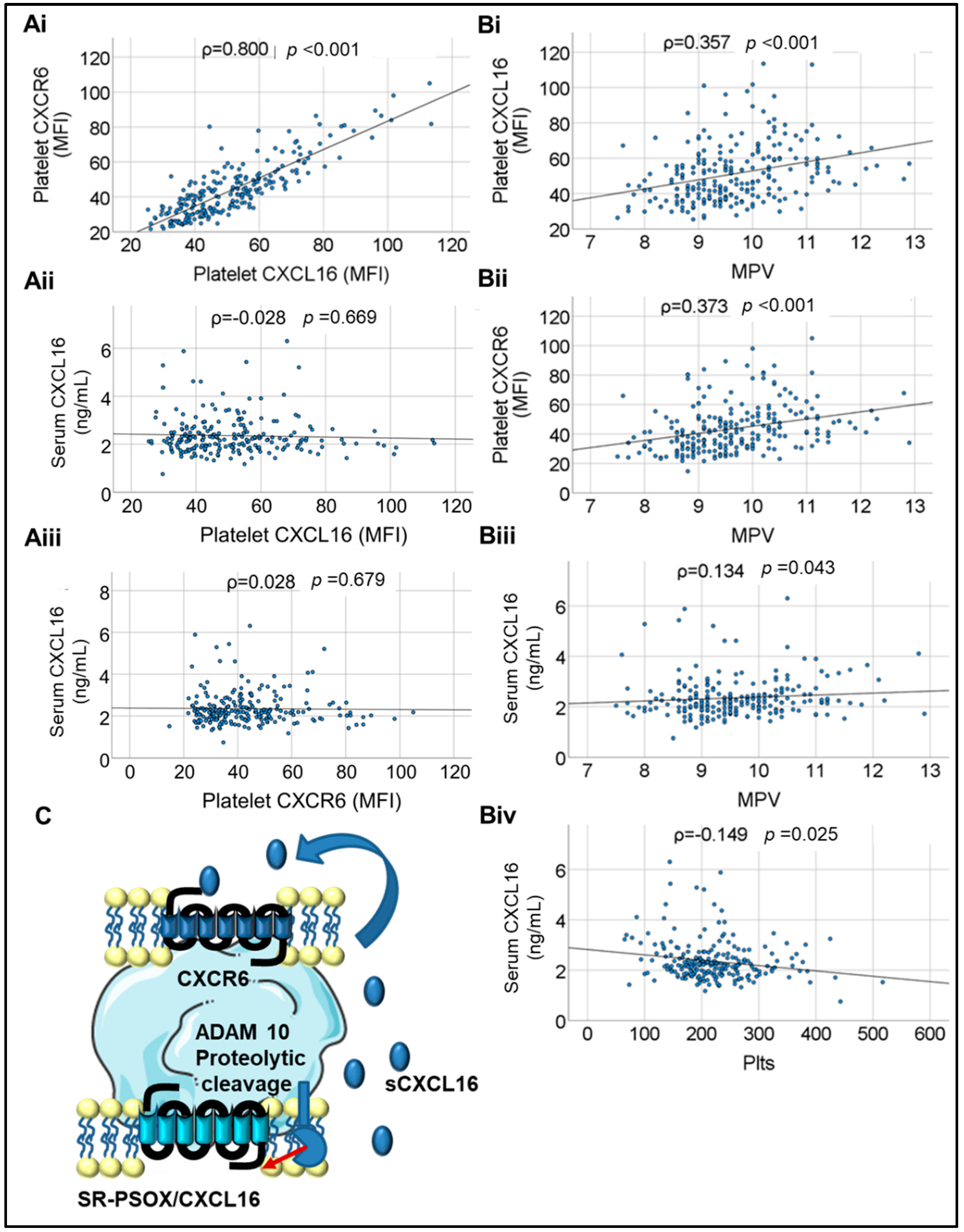
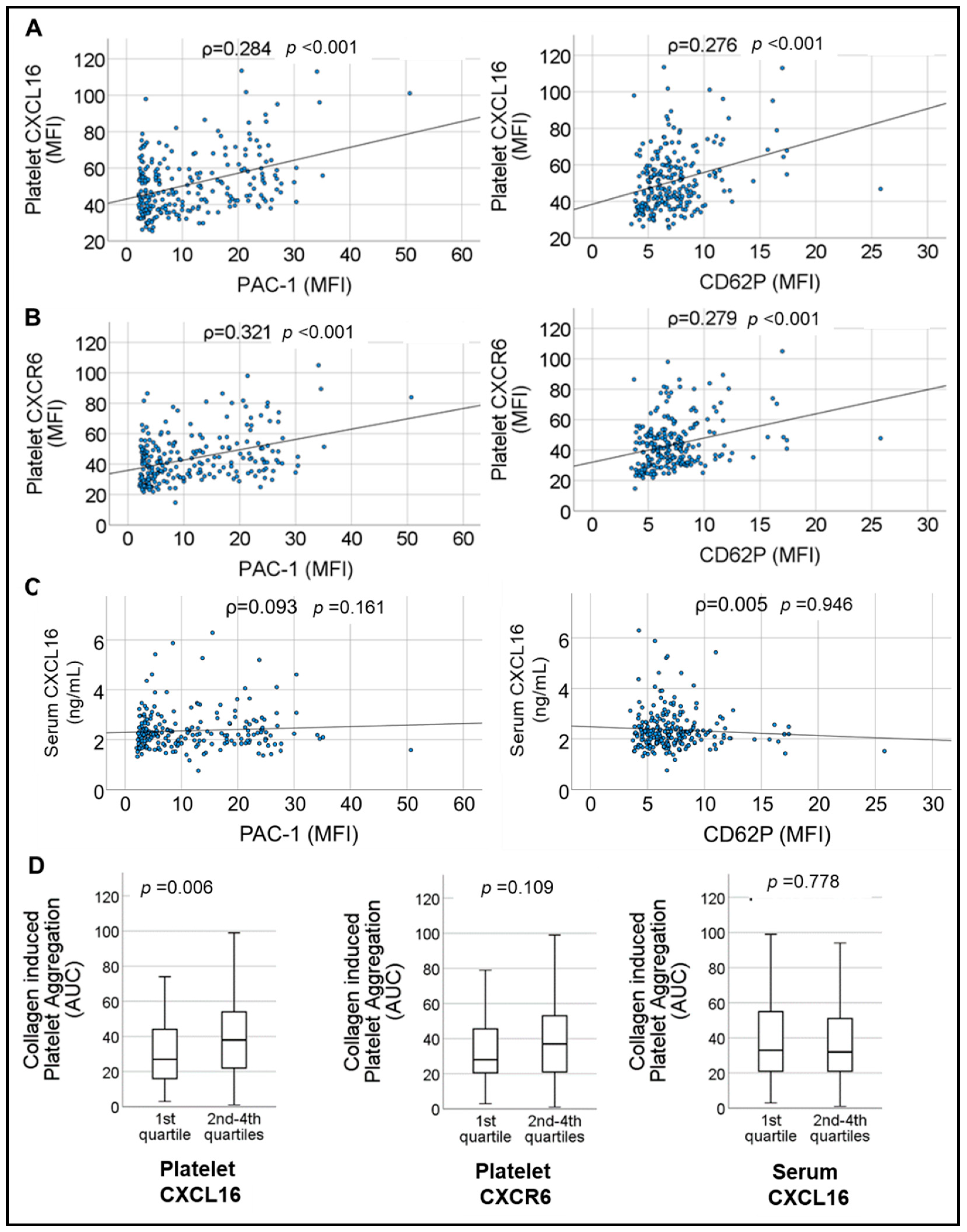
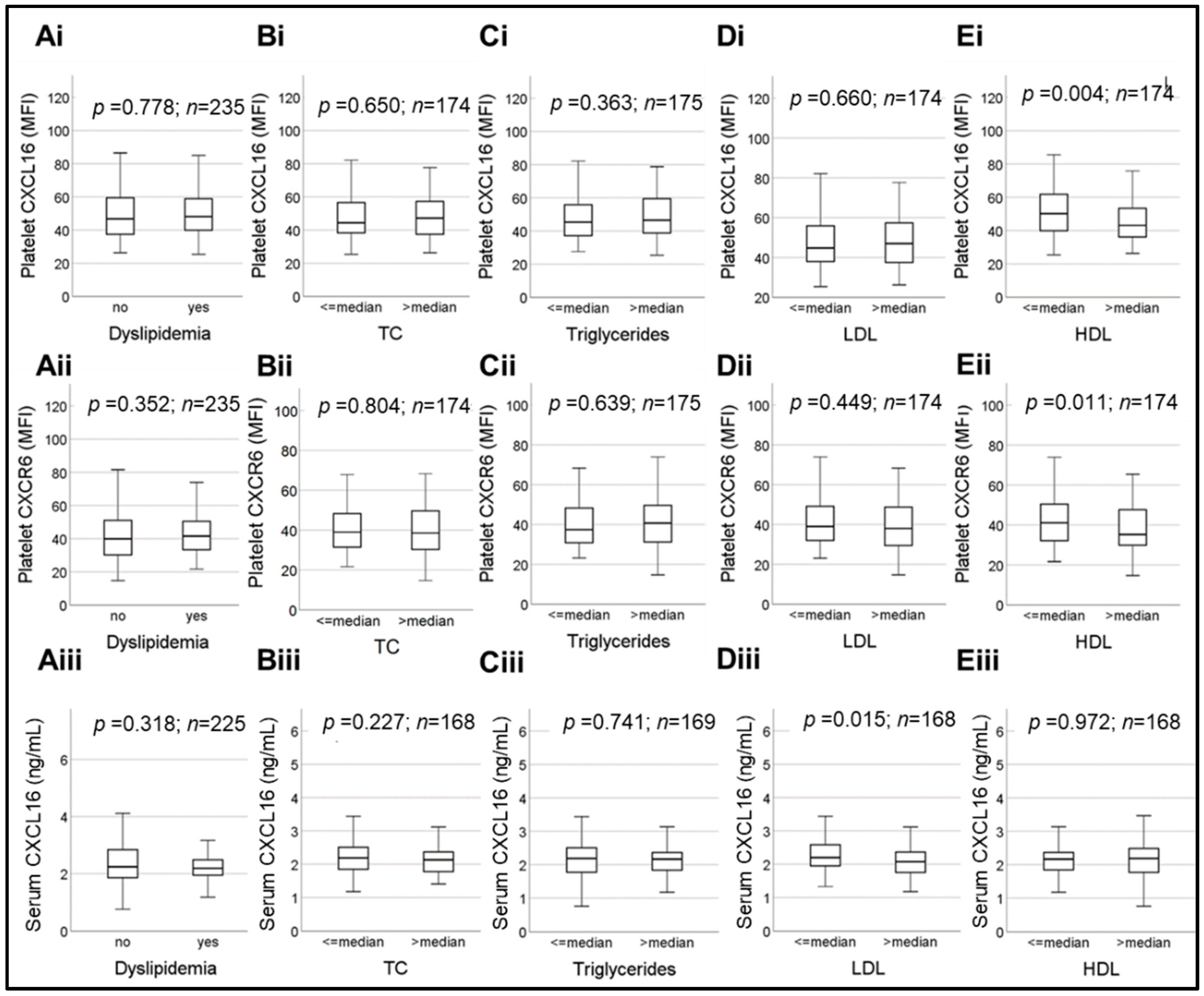
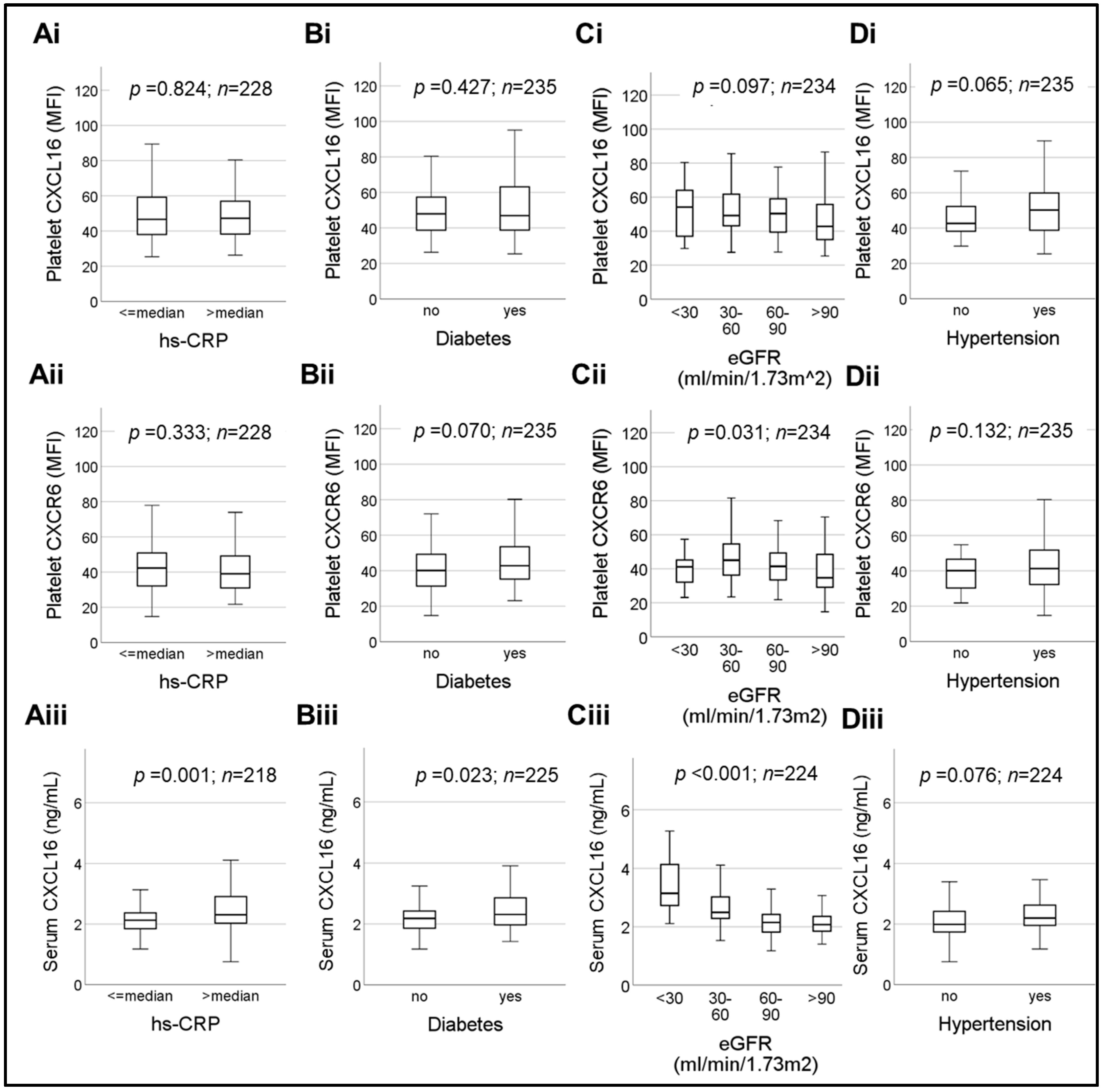
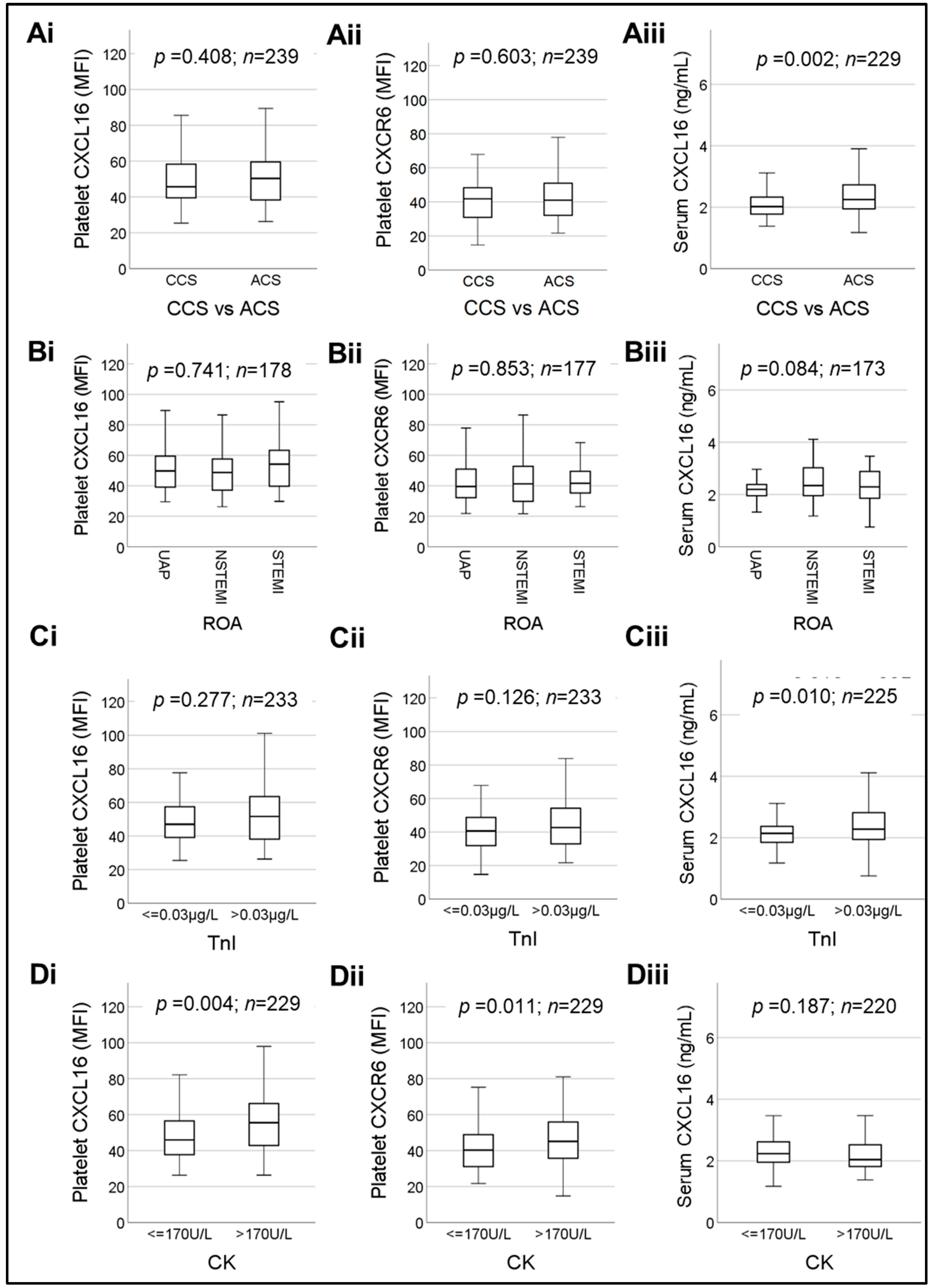
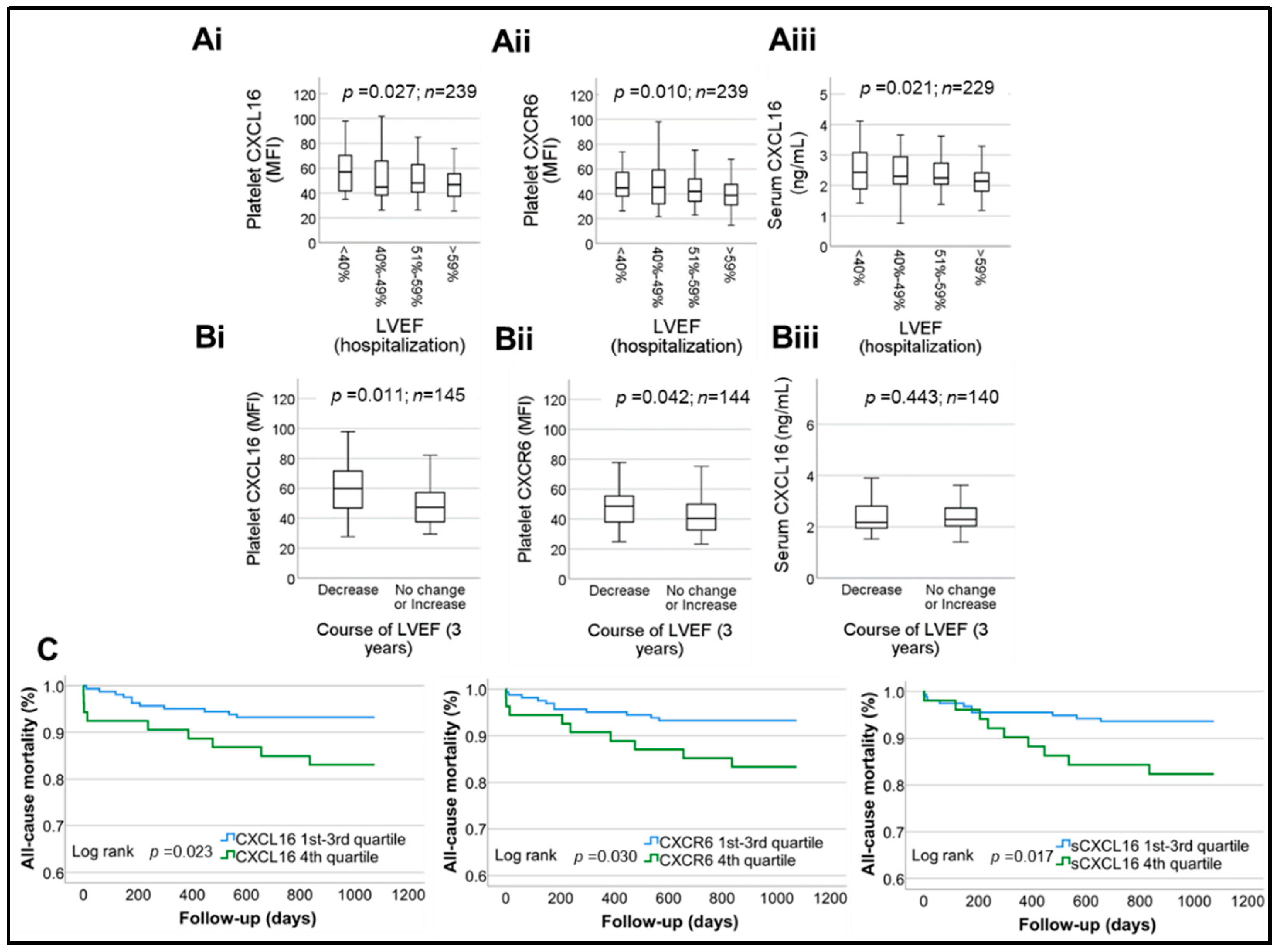
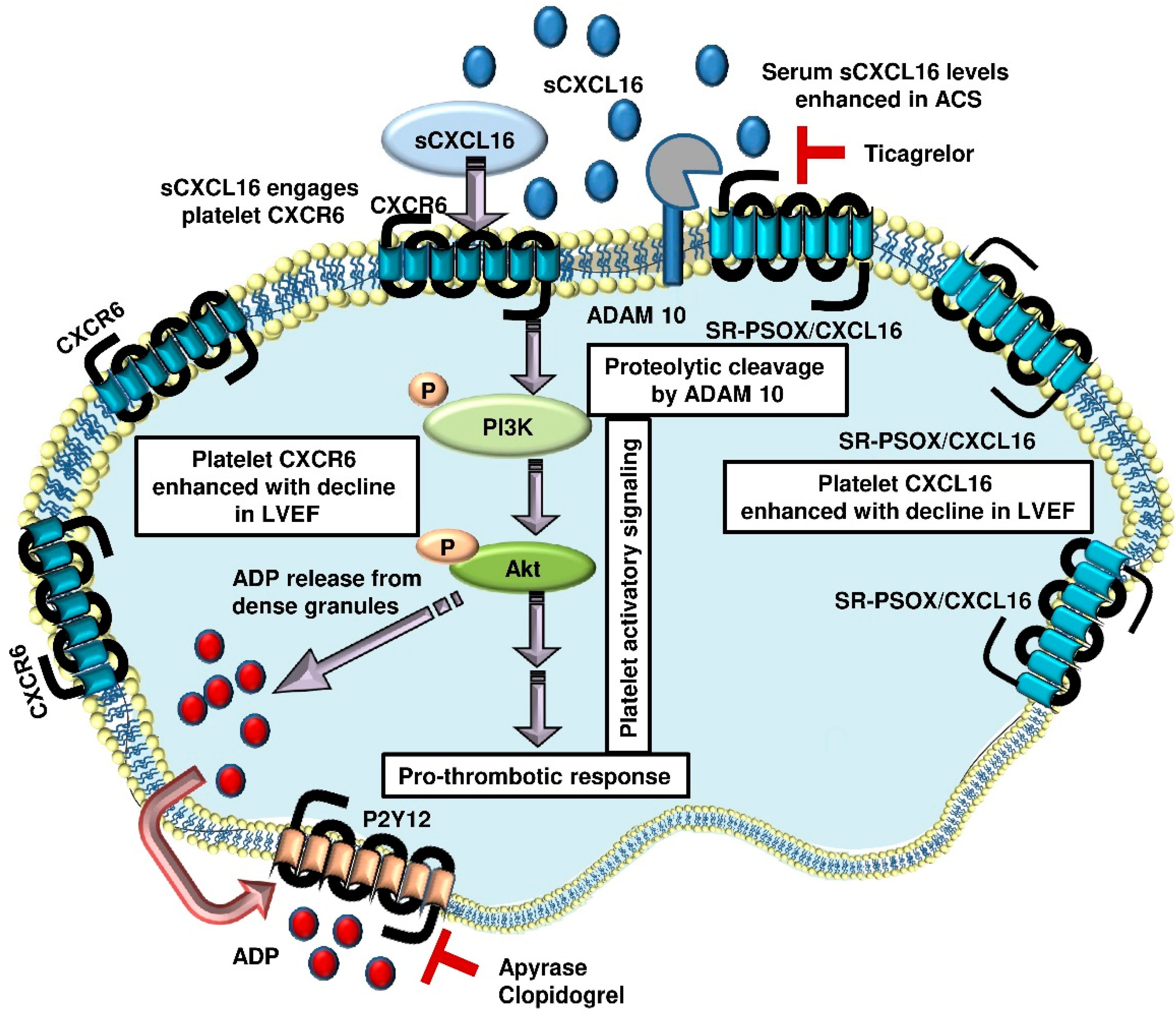
| CCS (n = 62) | ACS (n = 178) | p Value | |
|---|---|---|---|
| Age, years (mean ± SD) | 70 (±10.0) | 70 (±11.1) | 0.942 |
| Male, n (%) | 50 (80.6%) | 141 (79.2%) | 0.810 |
| NYHA I (%) | 21 (34.4%) | 31 (17.4%) | <0.001 |
| NYHA II (%) | 31 (50.0%) | 78 (43.8%) | |
| NYHA III (%) | 10 (16.1%) | 36 (20.2%) | |
| NYHA IV (%) | 0 (0.0%) | 33 (18.5%) | |
| CCS I (%) | 33 (53.2%) | 26 (14.6%) | <0.001 |
| CCS II (%) | 12 (19.4%) | 23 (12.9%) | |
| CCS III (%) | 17 (27.4%) | 47 (26.4%) | |
| CCS IV (%) | 0 (0.0%) | 82 (46.1%) | |
| Coronary sclerosis (%) | 6 (9.7%) | 9 (5.1%) | 0.349 |
| 1-vessel disease (%) | 8 (12.9%) | 35 (19.7%) | |
| 2-vessel disease (%) | 17 (27.4%) | 40 (22.5%) | |
| 3-vessel disease (%) | 31 (50.0%) | 94 (52.8%) | |
| Left main disease (%) | 21 (33.9%) | 40 (22.5%) | 0.076 |
| No to minimal MVR (%) | 13 (21.0%) | 42 (5.0%) | 0.364 |
| Mild MVR (%) | 42 (67.7%) | 110 (23.6%) | |
| Moderate MVR (%) | 7 (11.3%) | 20 (11.2%) | |
| Severe MVR (%) | 0 (0.0%) | 6 (3.4%) | |
| ICD (%) | 3 (4.8%) | 3 (1.7%) | 0.171 |
| Recent MI (%) | 5 (8.1%) | 4 (2.2%) | 0.038 |
| CXCL16 MFI (25th–75th percentile) | 45.7 (39.1–58.6) | 50.3 (38.3–59.6) | 0.408 |
| CXCR6 MFI (25th–75th percentile) | 41.8 (30.9–48.5) | 41.0 (32.0–51.0) | 0.603 |
| sCXCL16 ng/mL (25th–75th percentile) | 2.0 (1.8–2.3) | 2.2 (1.9–2.7) | 0.002 |
| Cardiovascular risk factors, n (%) | |||
| Arterial hypertension | 50 (80.6%) | 145 (81.5%) | 0.893 |
| Dyslipidemia | 44 (71.0%) | 95 (53.4%) | 0.015 |
| Diabetes mellitus | 19 (30.6%) | 47 (26.4%) | 0.520 |
| Current smokers | 22 (35.5%) | 47(26.4%) | 0.173 |
| Obesity | 11 (17.7%) | 23 (12.9%) | 0.349 |
| Family history | 15 (24.2%) | 37 (20.8%) | 0.576 |
| Echocardiography | |||
| LVEF, baseline% (mean ± SD) | 53 (±9.7) | 52 (±10.7) | 0.443 |
| LVEF, Follow-up% (mean ± SD) | 53 (±9.8) | 51 (±10.5) | 0.445 |
| Laboratory assessment upon admission, median (25th percentile–75th percentile) | |||
| Platelets, x 1000/µL | 211.0 (182.0–258.8) | 210.0 (173.5–255.0) | 0.559 |
| eGFR, mL/m² | 81.8 (67.9–94.0) | 74.4 (61.0–92.5) | 0.284 |
| hs-CRP, mg/dL (LG) | −0.88 (−1.40–−0.32) | −0.39 (−1.05–0.07) | 0.002 |
| Troponin I, ng/dL (LG) | −1.52 (−1.52–−1.52) | −1.52 (−1.52–−0.39) | <0.001 |
| NT pro-BNP, ng/L | 99 (21–387) | 393 (162–2696) | 0.088 |
| CK, U/L (LG) | 2.03 (1.79–2.15) | 2.00 (1.85–2.26) | 0.150 |
| HDL, mg/dL | 49 (39–56) | 45 (36–59) | 0.345 |
| LDL, mg/dL | 95.5 (65.5–127.5) | 106.0 (83.0–133.0) | 0.057 |
| TC, mg/dL | 166.5 (127.5–192.5) | 167.0 (146.0–201.0) | 0.337 |
| Triglycerides, mg/dL | 124.0 (93.8–161.3) | 128.0 (87.0–181.0) | 0.776 |
| Medication at admission, n (%) | |||
| ASA | 31 (50.0%) | 75 (42.1%) | 0.515 |
| Clopidogrel | 15 (23.1%) | 19 (10.7%) | 0.016 |
| Prasugrel | 2 (3.2%) | 3 (1.7%) | 0.521 |
| Ticagrelor | 7 (11.3%) | 8 (4.5%) | 0.081 |
| DAPT | 19 (30.6%) | 25 (14.0%) | 0.007 |
| ACE inhibitors | 23 (37.1%) | 51 (28.7%) | 0.359 |
| ARB | 19 (30.6%) | 44 (24.7%) | 0.543 |
| Aldosterone inhibitors | 5 (8.1%) | 9 (5.1%) | 0.467 |
| Thiazide diuretics | 10 (16.1%) | 24 (13.5%) | 0.784 |
| Loop diuretics | 8 (12.9%) | 21 (11.8%) | 0.992 |
| Calcium channel blockers | 13 (21.0%) | 22 (12.4%) | 0.086 |
| Beta-blockers | 35 (56.5%) | 76 (42.7%) | 0.127 |
| Statins | 37 (59.7%) | 70 (39.3%) | 0.011 |
| Oral anticoagulants | 12 (19.4%) | 23 (12.9%) | 0.281 |
| Medication at discharge, n (%) | |||
| ASA | 52 (83.9%) | 145 (81.5%) | 0.598 |
| Clopidogrel | 29 (46.8%) | 56 (31.5%) | 0.027 |
| Prasugrel | 5 (8.1%) | 30 (16.9%) | 0.092 |
| Ticagrelor | 13 (21.0%) | 55 (30.9%) | 0.137 |
| DAPT | 43 (69.4%) | 122 (68.5%) | 0.866 |
| ACE inhibitors | 27 (43.5%) | 88 (49.4%) | 0.433 |
| ARB | 20 (32.3%) | 60 (33.7%) | 0.850 |
| Aldosterone inhibitors | 7 (11.3%) | 42 (23.6%) | 0.039 |
| Thiazide diuretics | 11 (17.7%) | 32 (18.0%) | 0.978 |
| Loop diuretics | 11 (17.7%) | 31 (17.4%) | 0.943 |
| Calcium channel blockers | 19 (30.6%) | 44 (24.7%) | 0.349 |
| Beta-blockers | 39 (62.9%) | 128 (71.9%) | 0.183 |
| Statins | 55 (88.7%) | 156 (87.6%) | 0.733 |
| Oral anticoagulants | 11 (17.7%) | 32 (18.0%) | 0.978 |
| PCI vs. CABG vs. conservative treatment, n (%) | |||
| PCI | 42 (67.7%) | 143 (80.3%) | |
| CABG | 1 (1.6%) | 3 (1.7%) | |
| Conservative treatment | 19 (30.6%) | 32 (18.0%) | 0.110 |
| Diagnostic Parameters | Platelet CXCL16 | Platelet CXCR6 | sCXCL16 |
|---|---|---|---|
| Collagen-induced platelet aggregation | ρ = 0.167 p = 0.014 | ρ = 0.153 p = 0.025 | ρ = −0.055 p = 0.429 |
| Total cholesterol | ρ = −0.015 p = 0.849 | ρ = −0.078 p = 0.338 | ρ = −0.136 p = 0.098 |
| Triglycerides | ρ = 0.023 p = 0.773 | ρ = −0.053 p = 0.512 | ρ = −0.011 p = 0.896 |
| LDL | ρ = −0.021 p = 0.799 | ρ = −0.070 p = 0.387 | ρ = −0.089 p = 0.283 |
| HDL | ρ = −0.121 p = 0.136 | ρ = −0.104 p = 0.197 | ρ = −0.016 p = 0.844 |
| Hs-CRP | ρ = 0.008 p = 0.928 | ρ = −0.022 p = 0.749 | ρ = 0.226 p = 0.001 |
| eGFR | ρ = −0.160 p = 0.020 | ρ = −0.209 p = 0.002 | ρ = −0.406 p < 0.001 |
| TnI | ρ = 0.085 p = 0.218 | ρ = 0.065 p = 0.343 | ρ = 0.155 p = 0.027 |
| CK | ρ = 0.176 p = 0.011 | ρ = 0.108 p = 0.118 | ρ = −0.105 p = 0.141 |
| LVEF% baseline | ρ = −0.197 p = 0.004 | ρ = −0.224 p < 0.001 | ρ = −0.186 p = 0.007 |
| Course of LVEF% | ρ = −0.008 p = 0.913 | ρ = −0.035 p = 0.645 | ρ = −0.003 p = 0.965 |
| Patients Alive (n = 197) | Patients Deceased (n = 20) | p Value (Cox) | |
|---|---|---|---|
| Age, years (mean ± SD) | 70 (±10.5) | 78 (±7.6) | 0.002 |
| Male, n (%) | 154 (78.2%) | 18 (90.0%) | 0.245 |
| ACS, n (%) | 142 (72.1%) | 17 (85.0%) | 0.227 |
| NYHA I (%) | 41 (20.8%) | 3 (15.0%) | 0.004 |
| NYHA II (%) | 97 (49.2%) | 6 (30.0%) | |
| NYHA III (%) | 39 (19.8%) | 3 (15.0%) | |
| NYHA IV (%) | 20 (10.2%) | 8 (40.0%) | |
| CCS I (%) | 53 (26.9%) | 5 (25.0%) | 0.184 |
| CCS II (%) | 29 (14.7%) | 1 (5.0%) | |
| CCS III (%) | 51 (25.9%) | 3 (15.0%) | |
| CCS IV (%) | 64 (32.5%) | 11 (55.0%) | |
| Coronary sclerosis (%) | 13 (6.6%) | 0 (0.0%) | 0.033 |
| 1-vessel disease (%) | 37 (18.8%) | 1 (5.0%) | |
| 2-vessel disease (%) | 46 (23.4%) | 4 (20.0%) | |
| 3-vessel disease (%) | 101 (51.3%) | 15 (75.0%) | |
| Left main disease (%) | 49 (24.9%) | 8 (40.0%) | 0.142 |
| No to minimal MVR (%) | 45 (22.8%) | 1 (5.0%) | 0.103 |
| Mild MVR (%) | 124 (62.9%) | 13 (65.0%) | |
| Moderate MVR (%) | 22 (11.2%) | 4 (20.0%) | |
| Severe MVR (%) | 5 (2.5%) | 1 (5.0%) | |
| ICD (%) | 5 (2.5%) | 1 (5.0%) | 0.473 |
| Recent MI (%) | 7 (3.6%) | 1 (5.0%) | 0.756 |
| CXCL16 MFI (25th–75th percentile) | 47.1 (38.0–58.7) | 53.4 (40.1–71.1) | 0.102 |
| CXCR6 MFI (25th–75th percentile) | 40.8 (31.7–49.9) | 48.8 (40.9–65.9) | 0.040 |
| sCXCL16 ng/mL (25th–75th percentile) | 2.2 (1.9–2.5) | 2.4 (2.1–3.4) | 0.005 |
| CXCL16 (4th quartile vs. rest) | 44 (22.3%) | 9 (45.0%) | 0.029 |
| CXCR6 (4th quartile vs. rest) | 45 (22.8%) | 9 (45.0%) | 0.036 |
| sCXCL16 (4th quartile vs. rest) | 42 (21.3%) | 9 (45.0%) | 0.022 |
| Cardiovascular risk factors, n (%) | |||
| Arterial hypertension | 163 (82.7%) | 17 (85.0%) | 0.928 |
| Dyslipidemia | 118 (59.9%) | 8 (40.0%) | 0.072 |
| Diabetes mellitus | 49 (24.9%) | 9 (45.0%) | 0.068 |
| Current smokers | 58 (29.4%) | 3(15.0%) | 0.177 |
| Obesity | 28 (14.2%) | 2 (10.0%) | 0.592 |
| Family history | 46 (23.4%) | 2 (10.0%) | 0.191 |
| Echocardiography | |||
| LVEF, baseline% (mean ± SD) | 53 (±9.9) | 43.3 (±13.6) | <0.001 |
| LVEF, Follow-up% (mean ± SD) | 53 (±9.9) | 42.9 (±12.4) | 0.001 |
| Laboratory assessment upon admission, median (25th percentile–75th percentile) | |||
| Platelets, ×1000/µL | 212.0 (176.0–255.0) | 182.0 (131.8–230.5) | 0.765 |
| eGFR, mL/m² | 76.2 (63.2–93.0) | 60.1 (25.6–93.3) | 0.012 |
| hs-CRP, mg/dL (LG) | −0.61 (−1.19–−0.04) | −0.13 (−0.74–0.73) | 0.010 |
| Troponin I, ng/dL (LG) | −1.52 (−1.52–−1.02) | −0.74 (−1.52–0.70) | 0.004 |
| NT pro-BNP, ng/L | 354 (99–2012) | 393 (183–3379) | 0.921 |
| CK, U/L (LG) | 1.99 (1.82–2.23) | 1.90 (1.72–2.97) | 0.068 |
| HDL, mg/dL | 47 (39–58) | 39 (28–55) | 0.154 |
| LDL, mg/dL | 103.5 (77.3–132.8) | 86.0 (84.0–110.0) | 0.644 |
| TC, mg/dL | 167.0 (145.5–195.5) | 165.0 (141.0–179.0) | 0.443 |
| Triglycerides, mg/dL | 125.0 (88.3–167.8) | 142.0 (95.5–288.0) | 0.141 |
| Medication at admission, n (%) | |||
| ASA | 89 (45.2%) | 7 (35.0%) | 0.435 |
| Clopidogrel | 28 (14.2%) | 2 (10.0%) | 0.748 |
| Prasugrel | 4 (2.0%) | 1 (5.0%) | 0.334 |
| Ticagrelor | 11 (5.6%) | 2 (10.0%) | 0.377 |
| DAPT | 34 (17.3%) | 4 (20.0%) | 0.591 |
| ACE inhibitors | 58 (29.4%) | 7 (35.0%) | 0.333 |
| ARB | 54 (27.4%) | 3 (15.0%) | 0.317 |
| Aldosterone inhibitors | 12 (6.1%) | 1 (5.0%) | 0.944 |
| Thiazide diuretics | 30 (15.2%) | 2 (10.0%) | 0.671 |
| Loop diuretics | 23 (11.7%) | 4 (20.0%) | 0.208 |
| Calcium channel blockers | 29 (14.7%) | 1 (5.0%) | 0.297 |
| Beta-blockers | 95 (48.2%) | 8 (40.0%) | 0.760 |
| Statins | 91 (46.2%) | 7 (35.0%) | 0.543 |
| Oral anticoagulants | 29 (14.7%) | 4 (20.0%) | 0.371 |
| Medication at discharge, n (%) | |||
| ASA | 165 (83.8%) | 13 (65.0%) | 0.686 |
| Clopidogrel | 72 (36.5%) | 7 (35.0%) | 0.604 |
| Prasugrel | 30 (15.2%) | 0 (0%) | 0.289 |
| Ticagrelor | 56 (28.4%) | 6 (30.0%) | 0.474 |
| DAPT | 140 (71.1%) | 11 (55.0%) | 0.756 |
| ACE inhibitors | 94 (47.7%) | 10 (50.0%) | 0.294 |
| ARB | 70 (35.5%) | 4 (20.0%) | 0.378 |
| Aldosterone inhibitors | 42 (21.3%) | 4 (20.0%) | 0.765 |
| Thiazide diuretics | 41 (20.8%) | 0 (0%) | 0.210 |
| Loop diuretics | 32 (16.2%) | 7 (35.0%) | 0.017 |
| Calcium channel blockers | 57 (28.9%) | 0 (0%) | 0.134 |
| Beta-blockers | 140 (71.1%) | 12 (60.0%) | 0.797 |
| Statins | 177 (89.8%) | 15 (75.0%) | 0.738 |
| Oral anticoagulants | 35 (17.8%) | 4 (20.0%) | 0.484 |
| PCI vs. CABG vs. conservative treatment, n (%) | |||
| PCI | 148 (75.1%) | 19 (95.0%) | 0.128 |
| CABG | 4 (2.0%) | 0 (0.0%) | |
| Conservative treatment | 45 (22.8%) | 1 (5.0%) | |
| Variable | Hazard Ratio | 95% CI | p-Value |
|---|---|---|---|
| Age | 1.11 | 1.05–1.17 | <0.001 |
| LG troponin I | 1.96 | 1.39–2.76 | <0.001 |
| Platelet CXCL16 | 2.67 | 1.05–6.79 | 0.039 |
Publisher’s Note: MDPI stays neutral with regard to jurisdictional claims in published maps and institutional affiliations. |
© 2022 by the authors. Licensee MDPI, Basel, Switzerland. This article is an open access article distributed under the terms and conditions of the Creative Commons Attribution (CC BY) license (https://creativecommons.org/licenses/by/4.0/).
Share and Cite
Guan, T.; Emschermann, F.; Schories, C.; Groga-Bada, P.; Martus, P.; Borst, O.; Gawaz, M.; Geisler, T.; Rath, D.; Chatterjee, M. Platelet SR-PSOX/CXCL16–CXCR6 Axis Influences Thrombotic Propensity and Prognosis in Coronary Artery Disease. Int. J. Mol. Sci. 2022, 23, 11066. https://doi.org/10.3390/ijms231911066
Guan T, Emschermann F, Schories C, Groga-Bada P, Martus P, Borst O, Gawaz M, Geisler T, Rath D, Chatterjee M. Platelet SR-PSOX/CXCL16–CXCR6 Axis Influences Thrombotic Propensity and Prognosis in Coronary Artery Disease. International Journal of Molecular Sciences. 2022; 23(19):11066. https://doi.org/10.3390/ijms231911066
Chicago/Turabian StyleGuan, Tianyun, Frederic Emschermann, Christoph Schories, Patrick Groga-Bada, Peter Martus, Oliver Borst, Meinrad Gawaz, Tobias Geisler, Dominik Rath, and Madhumita Chatterjee. 2022. "Platelet SR-PSOX/CXCL16–CXCR6 Axis Influences Thrombotic Propensity and Prognosis in Coronary Artery Disease" International Journal of Molecular Sciences 23, no. 19: 11066. https://doi.org/10.3390/ijms231911066
APA StyleGuan, T., Emschermann, F., Schories, C., Groga-Bada, P., Martus, P., Borst, O., Gawaz, M., Geisler, T., Rath, D., & Chatterjee, M. (2022). Platelet SR-PSOX/CXCL16–CXCR6 Axis Influences Thrombotic Propensity and Prognosis in Coronary Artery Disease. International Journal of Molecular Sciences, 23(19), 11066. https://doi.org/10.3390/ijms231911066






